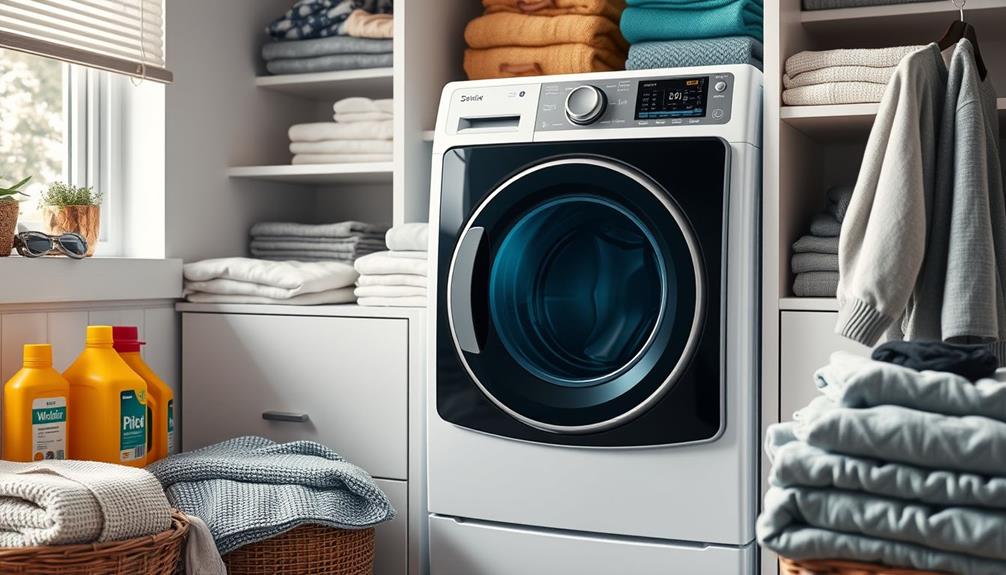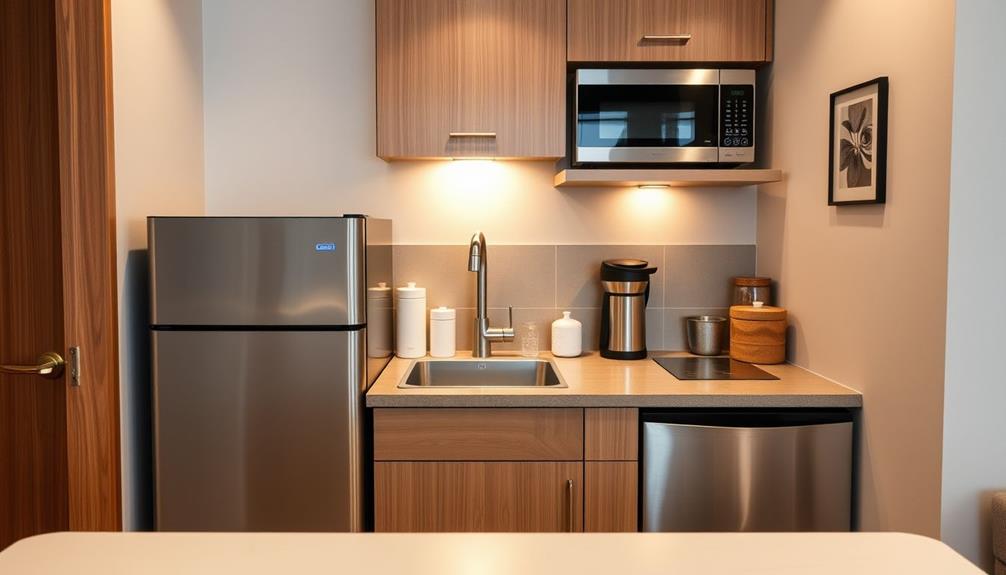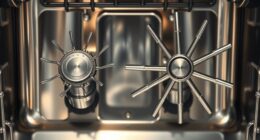Combo washer-dryers are a great option to consider if you have limited space and want convenience. They combine both washing and drying functions in one appliance, saving you time and energy. However, it is important to note that the drying capacity of these units may not always match the washing capacity, resulting in the need for multiple drying cycles for larger loads. Popular models like the LG WM3998HBA and GE Profile UltraFast are known for their efficiency and advanced features. It is worth mentioning that the drying performance may not always meet expectations. If you are comparing your options, there is more information to discover about the advantages and disadvantages of these versatile machines.
Key Takeaways
- Combo washer-dryers are space-efficient, ideal for small homes, but drying capacity often limits their effectiveness for larger loads.
- They offer convenience by combining wash and dry cycles, but longer drying times can hinder multitasking.
- Energy-efficient models save on electricity, but drying typically consumes significantly more energy than washing.
- Higher water consumption during drying can increase utility costs; some models use up to 210 liters per cycle.
- Consider top models like GE Profile UltraFast and LG WM3998HBA for advanced features and user satisfaction, especially in small households.
Overview of Washer-Dryer Combos
Washer-dryer combos offer a space-saving solution for those living in apartments or smaller homes, combining the washing and drying functions into one compact unit.
These appliances are designed with small spaces in mind, making them ideal for maximizing utility without sacrificing precious square footage. Most washer-dryer combos utilize ventless drying technology, which eliminates the need for external venting but often results in longer drying times, typically ranging from 3 to 6.5 hours.
To guarantee efficient operation, it's essential to select models that feature energy-efficient ratings, as they mimic the energy consumption of separate washer and dryer systems, allowing for energy-efficient models that reduce power consumption.
You'll find that the drying capacity of these units is generally about half that of their washing capacity. This means you might need to run multiple drying cycles for larger loads. However, they're energy-efficient, with average energy consumption comparable to separate washer and dryer systems. Many models come with ENERGY STAR ratings, assuring you're making an environmentally conscious choice.
Top brands like GE, LG, Samsung, and Whirlpool offer washer-dryer combos equipped with advanced features such as smart sensors and WiFi connectivity, enhancing ease of use.
These functionalities help optimize cleaning capability and streamline your laundry routine, making them a convenient choice for modern living.
How Combo Units Function
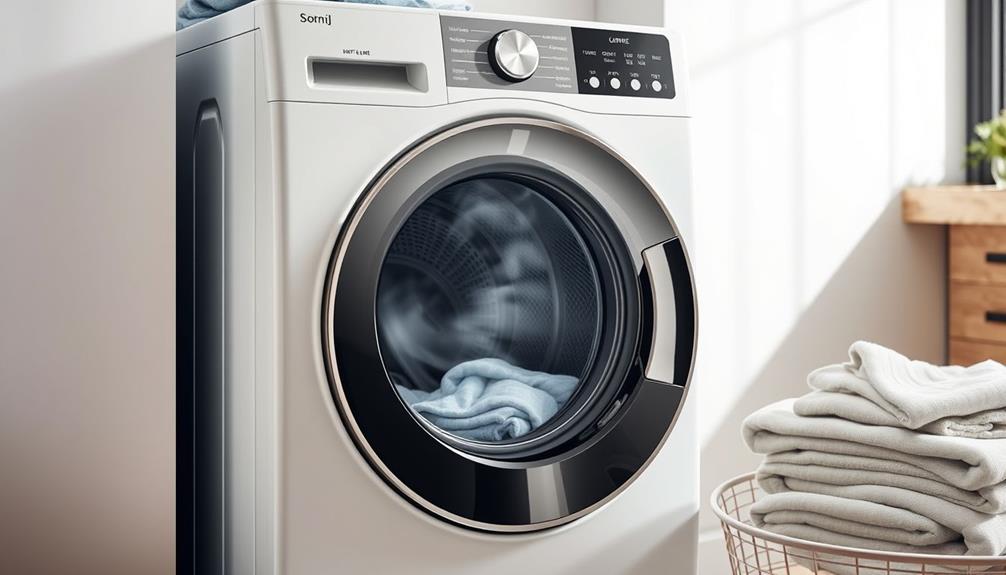
In many compact living situations, combo units serve as an efficient solution for laundry needs. A combo washer-dryer integrates a front-loading washing machine and a condenser dryer into a single unit, maximizing space-saving efficiency.
This setup utilizes a ventless drying system that captures moisture from your clothes and employs condensation to extract water. As air in a heat exchanger cools, it condenses moisture, allowing for effective drying without the need for external ventilation.
Additionally, dog health tips emphasize the significance of maintaining a clean environment for pets, which can include ensuring fresh laundry. Most models run on a standard 110-volt outlet, simplifying installations compared to standalone dryers that typically require 220 volts.
However, it's crucial to recognize that the drying capacity is usually about half that of the washing capacity. This means you may need to run multiple cycles for larger loads, which can extend your laundry time.
Typical wash and dry cycles can take anywhere from 3 to 6.5 hours, so careful scheduling is essential.
Advantages of Combo Washer-Dryers
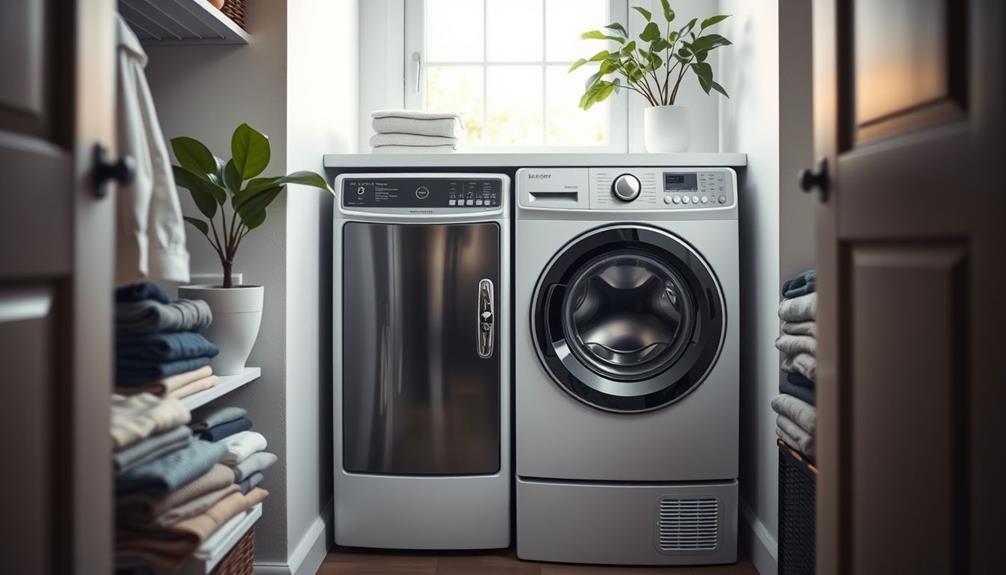
One major advantage of combo washer-dryers is their space efficiency, making them perfect for small homes or apartments where every square foot counts.
These units occupy about half the footprint of separate washer-dryer pairs, which is a game-changer in compact living situations. Additionally, for those who prioritize cleanliness, essential items for a home cleaning kit can complement your laundry routine by ensuring your clothes and laundry space are kept pristine.
The convenience they offer is unmatched; you can wash and dry your clothes in one cycle without needing to transfer laundry between machines.
This streamlines your laundry process, allowing you to tackle this chore quickly and efficiently.
Many modern combo washer-dryers also feature energy-efficient technology, such as heat pump dryers that use 28% less energy than standard dryers.
This can potentially lower your utility bills while being kinder to the environment.
Additionally, advanced features like smart sensors and sanitize cycles enhance your laundry experience by providing better control and flexibility.
With minimal installation requirements, typically just plug-and-play, you can easily set up a combo unit in various locations without worrying about external venting.
Disadvantages of Combo Washer-Dryers
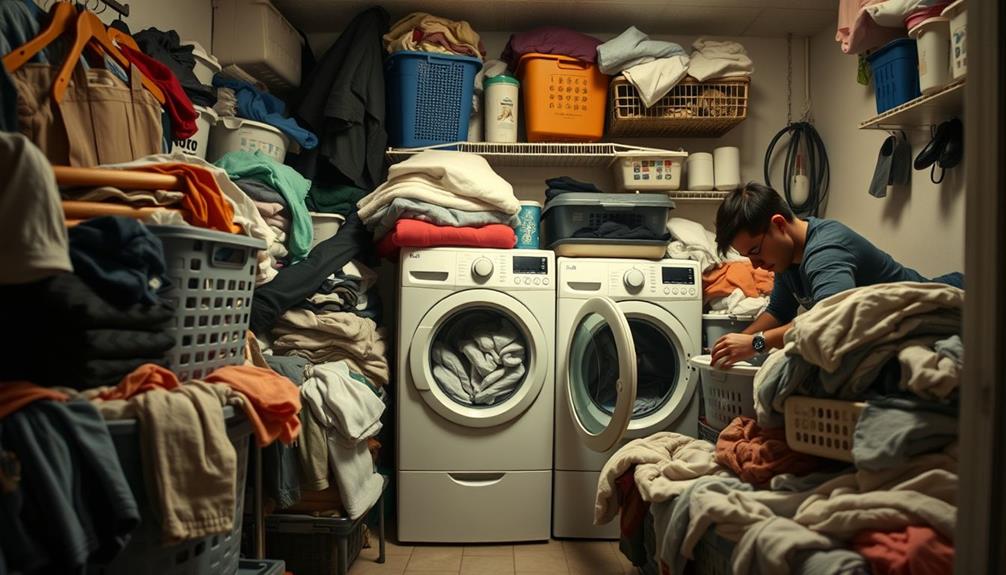
While combo washer-dryers offer several benefits, they also come with notable drawbacks that you should consider. One significant issue is their drying performance; many users find that clothes often remain damp after the drying cycle, leading to frustration. This inadequacy often means you'll need to run multiple drying cycles for a full load, which can be time-consuming.
Additionally, just like the importance of using air purifiers for maintaining indoor air quality, ensuring your laundry area is well-ventilated can help with moisture issues in clothes.
Here are some other disadvantages to keep in mind:
- Total time for combined wash and dry cycles can take 3 to 6.5 hours, much longer than separate machines.
- Combo washer-dryers typically have a drying capacity that's about half of their washing capacity.
- They tend to consume more water during the drying process, which can increase your utility costs.
- These units have historically experienced higher repair rates, raising maintenance concerns and potential costs.
Considering these issues is essential when deciding if a combo washer-dryer is the right choice for you. Balancing convenience with performance could make all the difference in your laundry routine.
Energy and Water Efficiency
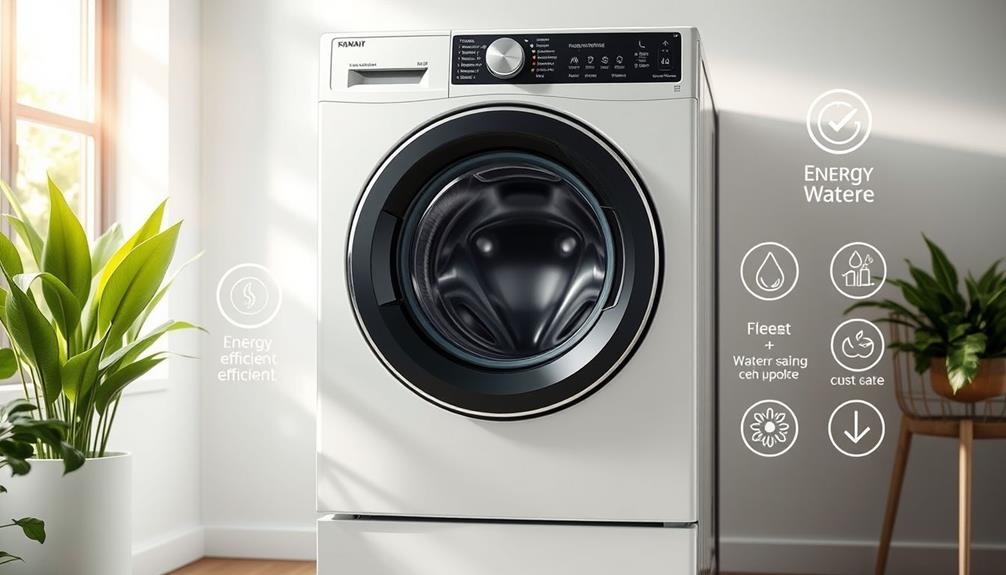
When it comes to energy consumption, combo washer-dryers can be surprisingly efficient, especially models with heat pump technology that save about 28% more energy than traditional dryers.
Many of these energy-efficient appliances also include features that enhance performance and lower overall utility costs, similar to garage door openers that focus on modern technology.
However, you'll want to keep an eye on water usage, as drying a typical load can use around 37 liters—sometimes even more.
Understanding these factors can help you make a more informed choice about your laundry appliances.
Energy Consumption Comparison
In today's energy-conscious world, understanding the energy and water efficiency of combo washer-dryers is essential for making informed choices.
When it comes to energy consumption, combo units typically use about ten times more energy for drying than for washing with cold water. This means energy efficiency plays a fundamental role in your overall utility costs.
Additionally, improper flushing practices can lead to increased water usage and waste, further affecting household expenses; for instance, clogging remedies can help maintain efficient plumbing.
Consider these key points when evaluating combo washer-dryers:
- Heat pump dryers in combo units use 28% less energy than standard dryers.
- Longer drying times can lead to increased energy use, despite overall energy consumption being comparable to standalone machines.
- Newer models with heat pump technology offer improved energy efficiency, but often come with a higher upfront cost.
- Selecting models with better water usage can greatly impact your utility bills.
- Evaluating long-term savings against initial investments is essential for budget-conscious shoppers.
Water Usage Insights
Understanding water usage in combo washer-dryers is essential for optimizing both energy and water efficiency in your home. These machines typically use an average of 37 liters of water to dry a 3.5kg load, but some models can consume as much as 210 liters. This variability underscores the importance of choosing the right model.
In addition, advancements in heat pump technology can enhance energy management by greatly reducing energy costs and water usage heat pump efficiency.
Newer models featuring heat pump technology stand out because they don't use water for drying, making them considerably more energy-efficient than traditional ventless models. In fact, the energy consumption for drying can be about ten times that of washing with cold water, so energy efficiency should be a top priority when selecting a combo washer-dryer.
While the overall energy use of these units is comparable to standalone washing machines and dryers, heat pump models can offer around 28% more energy efficiency than standard dryers.
However, keep in mind that average water usage for drying often isn't included in efficiency ratings, which can lead to confusion. Being aware of these factors will help you make a more informed decision on the best combo washer-dryer for your needs.
Capacity Considerations
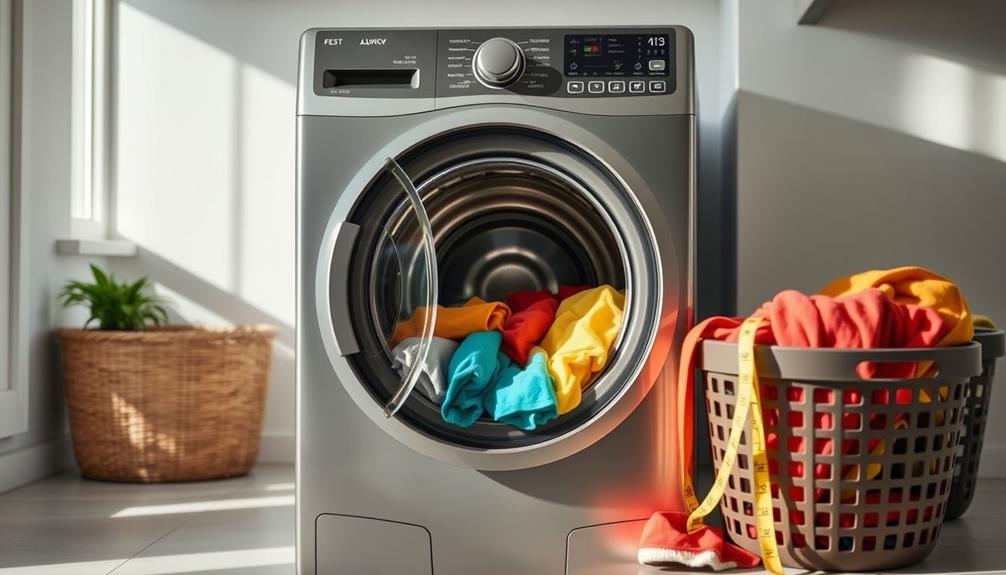
When it comes to capacity, you need to take into account both space limitations and load capacity challenges.
Many combo units have a drying capacity that's noticeably less than their washing capacity, which means you mightn't be able to dry everything you wash in one go. This can be particularly frustrating if you rely on your washer-dryer combo for larger loads or if you have a busy household.
It's also important to note that certain gas appliances, like gas dryers, may offer quicker drying times, especially during power outages when electricity is unavailable gas appliances typically function without electricity.
If you have a larger family or do frequent laundry, those long drying times can really complicate your routine.
Space Limitations
For those tight on space, combo washer-dryers offer a compact solution but come with notable capacity limitations.
These units typically have a drying capacity that's about half of their washing capacity, which can be a challenge when doing laundry for larger loads. If you're in a small household, this compact design might suit your needs, but larger families often find it inadequate.
Additionally, similar to how a self-cleaning mechanism in vacuums reduces maintenance efforts, a well-chosen combo washer-dryer can minimize the space and time required for laundry tasks.
Here are some considerations regarding space limitations with washer dryer combos:
- Drum Capacity: Limited space means less room for bulky items like comforters.
- Drying Capacity: Expect your drying capacity to be considerably lower than washing.
- Long Drying Times: Smaller loads may lead to longer drying times, leaving clothes damp.
- Optimal Performance: Aim for a test load of 3.5kg for the best results.
- Operational Inefficiencies: Full wash loads can hinder performance and extend cycle times.
Ultimately, while washer dryer combos excel in compact spaces, they may not deliver the efficiency needed for larger laundry needs.
Consider your household's demands before committing to one of these units.
Load Capacity Challenges
How do load capacity challenges affect your laundry routine with combo washer-dryers? If you own a combo machine, you might find that the drying capacity is roughly half of the washing capacity. This discrepancy often means you'll need multiple drying cycles for larger wash loads, complicating your laundry process.
Most models have a drum capacity between 1.6 to 5.3 cubic feet, and while larger capacities generally enhance drying performance, the compact drum can limit air circulation, negatively impacting drying effectiveness, especially for bulky items like comforters.
Additionally, if you're drawn to the aesthetics of modern farmhouse decor trends in your laundry space, consider how a combo washer-dryer fits into your overall design.
When you do a full wash load, you may need to dry it in two separate batches, which can extend your overall laundry time considerably. It's important to remember that the average test load for these combo machines is around 3.5 kg, making them better suited for individuals or small households.
Unfortunately, if you frequently wash bulky items, you could face ongoing load capacity challenges that disrupt your routine. Assess your laundry needs carefully to determine if a combo washer-dryer can keep up with your demands and whether it's worth the trade-offs in drying capacity and efficiency.
User Experience and Convenience

Combo washer-dryers offer a unique laundry solution that combines washing and drying in one compact unit, making them ideal for users with limited space.
The convenience of having an all-in-one machine can simplify your laundry routine, but it's important to evaluate a few aspects of user experience.
- Extended laundry time: Wash and dry cycles can take between 3 to 6.5 hours.
- Limited multitasking: You often need to wait for the drying cycle to finish before starting a new wash.
- Smaller drying capacity: These units typically handle about half the load that standalone dryers can manage.
- Variable user satisfaction: Some users love the compact design, while others struggle with drying performance.
- Space-saving design: An excellent option for apartments or small homes.
While the combo washer-dryer offers undeniable convenience, it's vital to assess these factors against your laundry needs.
Extended cycle durations and limited drying capacity might lead to frustration, especially if you're used to the efficiency of separate machines.
Ultimately, understanding these user experience aspects can help you decide if a combo washer-dryer meets your expectations for performance and convenience.
Top Models to Consider
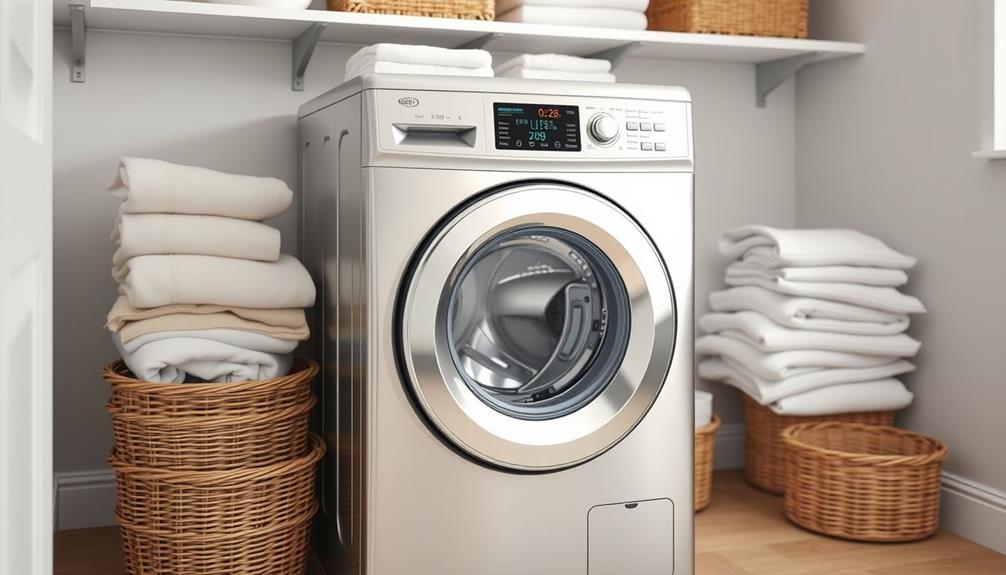
When searching for the perfect washer-dryer combo, several top models stand out for their performance and features. One of the leading options is the GE Profile UltraFast Combo, which launched in mid-2023 and is praised for its energy efficiency and advanced functionalities.
If you're looking for a spacious choice, the LG WM3998HBA offers 4.5 cubic feet of capacity and a variety of wash and dry cycles, making it ideal for small households.
For eco-conscious consumers, Samsung's WD10T534DBN incorporates EcoBubble technology to enhance cleaning performance while maintaining energy efficiency.
If smart technology is important to you, the Whirlpool WFC8090GX allows you to monitor your laundry remotely via an app, combining convenience with its 2-in-1 washer-dryer combo functionality.
Finally, consider the Bosch WAT28400UC, which is compact yet efficient, providing a reliable 2.2 cubic feet capacity perfect for tight living spaces.
These models cater to various needs and preferences, ensuring you can find a washer-dryer combo that fits your lifestyle while delivering excellent washing and drying capabilities.
Performance Ratings and Comparisons
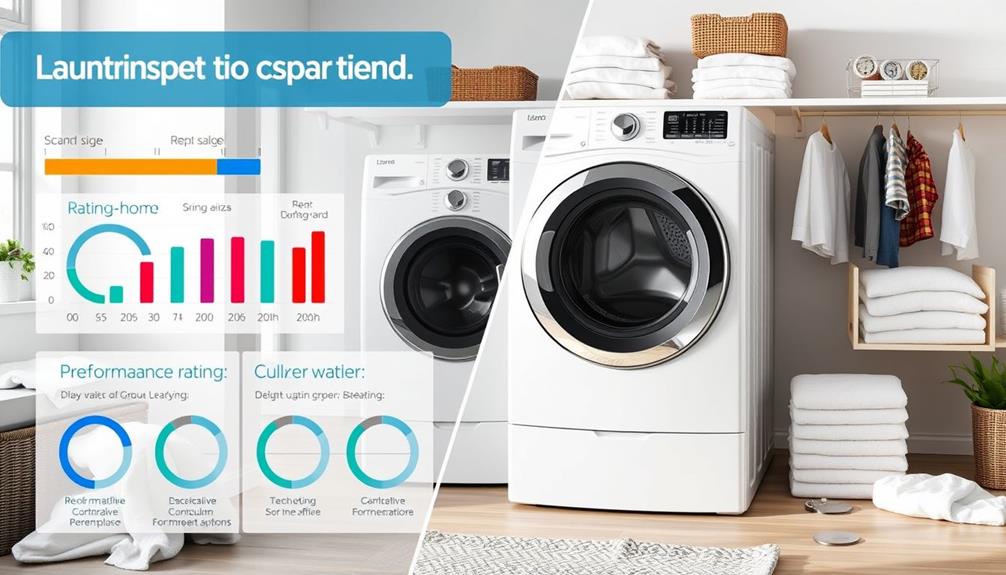
When you're choosing a combo washer-dryer, it's essential to assess drying efficiency alongside washing performance.
You'll find that while washing results can match standalone units, drying times often leave much to be desired.
Additionally, comparing energy consumption across models can help you find an option that balances performance with efficiency.
Drying Efficiency Assessment
Evaluating the drying efficiency of washer-dryer combos reveals a significant gap in performance compared to standalone dryers. Most combo washer-dryers struggle with poor drying, often requiring extended drying times that can range from 3 to 6.5 hours. In contrast, standalone dryers can typically finish the job in under an hour.
Here are some key points to take into account:
- Capacity Limitations: These units usually dry only half of their washing capacity. A 4.5 cubic feet washer may effectively dry just 2 to 2.5 cubic feet of laundry.
- Performance Ratings: Many models receive low scores for drying efficiency, leaving clothes damp after a full cycle.
- Moisture Extraction: Poor moisture extraction often leads to the need for additional drying cycles.
- Heat Pump Dryer Technology: While energy-efficient, it still results in extended drying times—some models can take over 6 hours.
- Consumer Reviews: Users frequently express dissatisfaction, noting that items often remain damp, necessitating manual intervention.
Ultimately, if you prioritize drying efficiency, you might find that combo washer-dryers don't meet your needs.
Washing Performance Comparison
Washer-dryer combos deliver washing performance that often rivals standalone front-loading machines, efficiently tackling a variety of fabric types and soil levels.
These appliances typically boast high washing efficiency, making them suitable for everyday laundry needs. However, when it comes to drying effectiveness, there's a noticeable gap. Consumer feedback reveals that while many combos mirror the washing features of traditional washers, their drying capabilities can leave clothes damp, necessitating additional drying time or cycles.
Average drying times for washer-dryer combos range from 3.5 to over 6 hours, depending on the model. This can be a significant drawback if you're used to the quicker drying times of separate machines.
Moreover, the average capacity for washing in these combos ranges from 2.5 to 4.5 cubic feet, which might limit the amount of laundry you can clean in one cycle.
Advanced models equipped with smart technology and multiple wash settings can optimize washing performance, yet they still struggle with drying efficiency and longer overall cycle times.
Ultimately, if washing performance is your priority, these combos can be an effective choice, but be prepared for some compromises on drying.
Energy Consumption Analysis
Energy efficiency is an essential factor to take into account when choosing a washer-dryer combo, especially since these appliances have varying impacts on your utility bills.
Understanding energy consumption can lead to significant cost savings in the long run.
Here are some key points to remember:
- Heat pump technology can reduce energy use by up to 28% compared to standard dryers.
- The drying process typically consumes about ten times more energy than washing with cold water, highlighting its substantial energy demands.
- Models like the GE Profile UltraFast Combo may take up to 3.5 hours to dry a 12-pound load, and some can exceed six hours, increasing energy use.
- Look for ENERGY STAR ratings on washer-dryer combos to guarantee you're selecting an energy-efficient model.
- While the average cost for a heat pump washer-dryer combo is around $3000, tax rebates can offset this initial expense while providing ongoing energy savings.
Is a Combo Right for You?

If you live in a small space or want to maximize your laundry efficiency, a combo washer-dryer could be a great fit for you. These space-saving units combine two appliances into one, making them ideal for apartments or homes with limited laundry space. However, you should take into account a few factors before committing.
| Pros | Cons | Best For |
|---|---|---|
| Space-saving design | Limited drying capacity | Individuals or couples |
| Easy installation (110V) | Long drying times (3-6.5 hrs) | Minimal laundry needs |
| Smart sensors for efficiency | Not suitable for large households | Modern user preferences |
Combo units typically have a washing capacity that's double the drying capacity, which can lead to longer drying times. If you're an individual or a couple with light laundry needs, they can work well for you. Plus, many models feature smart sensors and WiFi connectivity, aligning with modern user preferences for convenience. However, if you find yourself doing laundry for a larger household, you might want to take into account traditional washer-dryer pairs for better efficiency and capacity.
Frequently Asked Questions
What Are the Cons of a Washer/Dryer Combo?
You'll find that washer-dryer combos often leave clothes damp, take longer to complete cycles, and have limited drying capacity. Plus, they can require more repairs, leading to higher maintenance costs and potential frustration in the long run.
Why Aren't Washer-Dryer Combos More Popular?
Washer-dryer combos aren't more popular because they often struggle with drying efficiency, lengthy cycles, and reliability issues. You might find better performance and value in separate machines, especially if you're budget-conscious or need faster laundry solutions.
What Is the Most Reliable Brand of Washer and Dryer Combo?
When considering reliability in washer-dryer combos, you can't go wrong with LG or Samsung. Both brands excel in performance and energy efficiency, ensuring you get dependable results without frequent maintenance hassles. You'll appreciate their advanced features!
What Is the Advantage of a Washer and Dryer Combo?
You'll love how a washer-dryer combo crams two chores into one appliance, saving you from those "exhilarating" laundry transfers. Plus, it's space-saving, energy-efficient, and lets you binge-watch while it handles your dirty laundry.
Conclusion
In the whirlwind of laundry day, combo washer-dryers can be your trusty sidekick, blending convenience with efficiency. They save space and simplify your routine, but they come with trade-offs that might not suit everyone's needs. If you're juggling tight quarters or seeking a streamlined solution, these machines might just be your laundry lifeline. However, if performance and capacity are your top priorities, you might want to explore other options. Choose wisely, and let laundry day become a breeze!
